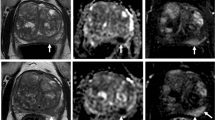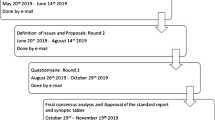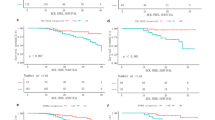Abstract
Purpose
To define the value of clinical and radiological data, using multiparametric magnetic resonance imaging (mpMRI), to predict prostate cancer (PCa) in prostate imaging reporting and data system version 2.1 (PIRADSv2.1) 3 lesions of the peripheral and the transition zones (PZ and TZ).
Methods
The mpMRI of patients with PIRADSv2.1 3 lesions who had undergone fusion targeted biopsy was reviewed. Morphological pattern, diffusion parameters and vascularisation were evaluated. The radiological/histopathological data of benign and malignant lesions, between the PZ and TZ were compared. Univariate and multivariate analyses were carried out to identify the clinical and radiological data capable of predicting PCa.
Results
One hundred and twenty-three lesions were assessed, 93 (76%) in the PZ and 30 (24%) in the TZ. Of these, 56 (46%) were PCa and 67 (54%) were benign. The majority of the PCas were Grade Group System (GGS) 1 (38%) and GGS 2 (39%); tumours having a GGS ≥ 3 were more frequently in the TZ (p = 0.02). Univariate analysis showed a significant correlation between PCa and prostate volume, prostate-specific antigen (PSA) density, lesion zone and the apparent diffusion coefficient. At multivariate logistic regression PSA density > 0.15 ng/ml/ml {Odds ratio [OR] 2.38; p = 0.001} and lesion zone (i.e. TZ OR 7.55) were independent predictors of PCa (all p ≤ 0.04).
Conclusion
In solitary PIRADSv2.1 3 lesions, the most important predictive factor was the location zone, with a much greater risk for TZ lesions.




Similar content being viewed by others
References
Fandella A, Scattoni V, Galosi A, Pepe P et al (2017) Italian prostate biopsies group: 2016 updated guidelines insights. Anticancer Res 37(2):413–424. https://doi.org/10.21873/anticanres.11333
Schiavina R, Chessa F, Borghesi M et al (2019) State-of-the-art imaging techniques in the management of preoperative staging and re-staging of prostate cancer. Int J Urol 26(1):18–30. https://doi.org/10.1111/iju.13797
Hamoen EHJ, de Rooij M, Witjes JA, Barentsz JO, Rovers MM (2015) Use of the prostate imaging reporting and data system (PI-RADS) for prostate cancer detection with multiparametric magnetic resonance imaging: a diagnostic meta-analysis. Eur Urol 67(6):1112–1121. https://doi.org/10.1016/j.eururo.2014.10.033
Zhang L, Tang M, Chen S, Lei X, Zhang X, Huan Y (2017) A meta-analysis of use of prostate imaging reporting and data system version 2 (PI-RADS V2) with multiparametric MR imaging for the detection of prostate cancer. Eur Radiol 27(12):5204–5214. https://doi.org/10.1007/s00330-017-4843-7
Ahmed HU, El-Shater Bosaily A, Brown LC et al (2017) Diagnostic accuracy of multi-parametric MRI and TRUS biopsy in prostate cancer (PROMIS): a paired validating confirmatory study. Lancet 389(10071):815–822. https://doi.org/10.1016/S0140-6736(16)32401-1
Kasivisvanathan V, Rannikko AS, Borghi M et al (2018) MRI-targeted or standard biopsy for prostate-cancer diagnosis. N Engl J Med 378(19):1767–1777. https://doi.org/10.1056/NEJMoa1801993
Barentsz JO, Richenberg J, Clements R et al (2012) ESUR prostate MR guidelines 2012. Eur Radiol 22(4):746–757. https://doi.org/10.1007/s00330-011-2377-y
Weinreb JC, Barentsz JO, Choyke PL et al (2016) PI-RADS prostate imaging—reporting and data system: 2015, version 2. Eur Urol 69(1):16–40. https://doi.org/10.1016/j.eururo.2015.08.052
Turkbey B, Rosenkrantz AB, Haider MA et al (2019) Prostate imaging reporting and data system version 2.1: 2019 update of prostate imaging reporting and data system version 2. Eur Urol 76(3):340–351. https://doi.org/10.1016/j.eururo.2019.02.033
Hansen NL, Barrett T, Kesch C, Pepdjonovic L et al (2018) Multicentre evaluation of magnetic resonance imaging supported transperineal prostate biopsy in biopsy-naïve with suspicion of prostate cancer. BJU Int 122(1):40–49. https://doi.org/10.1111/bju.14049
Steinkohl F, Gruber L, Bektic J et al (2018) Retrospective analysis of the development of PIRADS 3 lesions over time: when is a follow-up MRI reasonable? World J Urol 36(3):367–373. https://doi.org/10.1007/s00345-017-2135-0
Liddell H, Jyoti R, Haxhimolla HZ (2015) mp-MRI prostate characterised PIRADS 3 lesions are associated with a low risk of clinically significant prostate cancer—a retrospective review of 92 biopsied PIRADS 3 lesions. Curr Urol 8(2):96–100. https://doi.org/10.1159/000365697
Tan N, Lin WC, Khoshnoodi P et al (2017) In-bore 3-T MR-guided transrectal targeted prostate biopsy: prostate imaging reporting and data system version 2–based diagnostic performance for detection of prostate cancer. Radiology 283:130–139. https://doi.org/10.1148/radiol.2016152827
Hansen NL, Koo BC, Warren AY, Kastner C, Barrett T (2017) Sub-differentiating equivocal PI-RADS-3 lesions in multiparametric magnetic resonance imaging of the prostate to improve cancer detection. Eur J Radiol 95:307–313. https://doi.org/10.1016/j.ejrad.2017.08.017
Mehralivand S, Bednarova S, Shih JH et al (2017) Prospective evaluation of PI-RADS™ version 2 using the International Society of Urological Pathology Prostate Cancer Grade Group System. J Urol 198:583–590. https://doi.org/10.1016/j.juro.2017.03.131
Thompson J, Lawrentschuk N, Frydenberg M, Thompson L, Stricker P (2013) The role of magnetic resonance imaging in the diagnosis and management of prostate cancer. BJU Int 112(suppl 2):6–20. https://doi.org/10.1111/bju.12381
Rosenkrantz AB, Kim S, Lim RP et al (2013) Prostate cancer localization using multiparametric MR imaging: comparison of prostate imaging reporting and data system (PI-RADS) and Likert scales. Radiology 269(2):482–492. https://doi.org/10.1148/radiol.13122233
Schimmöller L, Quentin M, Arsov C et al (2013) Inter-reader agreement of the ESUR score for prostate MRI using in-bore MRI-guided biopsies as the reference standard. Eur Radiol 23(11):3185–3190. https://doi.org/10.1007/s00330-013-2922-y
Giannarini G, Girometti R, Crestani A et al (2019) A prospective accuracy study of prostate imaging reporting and data system version 2 on multiparametric magnetic resonance imaging in detecting clinically significant prostate cancer with whole mount pathology. Urology 123:191–197. https://doi.org/10.1016/j.urology.2018.07.067
Smith CP, Harmon SA, Barrett T et al (2019) Intra- and interreader reproducibility of PI-RADSv2: a multireader study. J Magn Reson Imaging 49(6):1694–1703. https://doi.org/10.1002/jmri.26555
Maggi M, Panebianco V, Mosca A et al (2020) Prostate imaging reporting and data system 3 category cases at multiparametric magnetic resonance for prostate cancer: a systematic review and meta-analysis. Eur Urol Focus 6(3):463–478. https://doi.org/10.1016/j.euf.2019.06.014
Rosenkrantz AB, Babb JS, Taneja SS, Ream JM (2017) Proposed adjustments to PI-RADS version 2 decision rules: impact on prostate cancer detection. Radiology 283:119–129. https://doi.org/10.1148/radiol.2016161124
Brizmohun Appayya M, Sidhu HS, Dikaios N et al (2018) Characterizing indeterminate (Likert-score 3/5) peripheral zone prostate lesions with PSA density, PI-RADS scoring and qualitative descriptors on multiparametric MRI. Br J Radiol 91(1083):20170645. https://doi.org/10.1259/bjr.20170645
Sheridan AD, Nath SK, Syed JS et al (2018) Risk of clinically significant prostate cancer associated with prostate imaging reporting and data system category 3 (equivocal) lesions identified on multiparametric prostate MRI. AJR Am J Roentgenol 210(2):347–357. https://doi.org/10.2214/AJR.17.18516
Felker ER, Raman SS, Margolis DJ et al (2017) Risk stratification among men with prostate imaging reporting and data system version 2 category 3 transition zone lesions: is biopsy always necessary? AJR Am J Roentgenol 209(6):1272–1277. https://doi.org/10.2214/AJR.17.18008
Kim TJ, Lee MS, Hwang SI, Lee HJ, Hong SK (2019) Outcomes of magnetic resonance imaging fusion-targeted biopsy of prostate imaging reporting and data system 3 lesions. World J Urol 37(8):1581–1586. https://doi.org/10.1007/s00345-018-2565-3
Gómez Rivas J, Giganti F, Álvarez-Maestro M et al (2019) Prostate indeterminate lesions on magnetic resonance imaging-biopsy versus surveillance: a literature review. Eur Urol Focus 5(5):799–806. https://doi.org/10.1016/j.euf.2018.02.012
Hermie I, Van Besien J, De Visschere P, Lumen N, Decaestecker K (2019) Which clinical and radiological characteristics can predict clinically significant prostate cancer in PI-RADS 3 lesions? A retrospective study in a high-volume academic center. Eur J Radiol 114:92–98. https://doi.org/10.1016/j.ejrad.2019.02.031
Görtz M, Radtke JP, Hatiboglu G et al (2019) The value of prostate-specific antigen density for prostate imaging reporting and data system 3 lesions on multiparametric magnetic resonance imaging: a strategy to avoid unnecessary prostate biopsies. Eur Urol Focus. https://doi.org/10.1016/j.euf.2019.11.012
Kotb AF, Spaner S, Crump T, Hyndman ME (2018) The role of mpMRI and PSA density in patients with an initial negative prostatic biopsy. World J Urol 36(12):2021–2025. https://doi.org/10.1007/s00345-018-2341-4
Distler FA, Radtke JP, Bonekamp D et al (2017) The value of PSA density in combination with PI-RADS™ for the accuracy of prostate cancer prediction. J Urol 198(3):575–582. https://doi.org/10.1016/j.juro.2017.03.130
Schiavina R, Bianchi L, Borghesi M et al (2018) MRI displays the prostatic cancer anatomy and improves the bundles management before robot-assisted radical prostatectomy. J Endourol 32(4):315–321. https://doi.org/10.1089/end.2017.0701
Miyai K, Mikoshi A, Hamabe F et al (2019) Histological differences in cancer cells, stroma, and luminal spaces strongly correlate with in vivo MRI-detectability of prostate cancer. Mod Pathol 32(10):1536–1543. https://doi.org/10.1038/s41379-019-0292-y
Funding
This study has no source(s) of support in the form of grants, equipment or drugs.
Author information
Authors and Affiliations
Corresponding author
Ethics declarations
Conflict of interest
All the authors declare that they have no conflict of interest.
Ethical approval
The study was approved by our local institution review board and conducted in accordance with institutional guidelines, including the Declaration of Helsinki (Approval code: STUD-OF, Prot. N. 323).
Informed consent
All patients were notified of the investigational nature of this study and gave their written informed consent.
Additional information
Publisher's Note
Springer Nature remains neutral with regard to jurisdictional claims in published maps and institutional affiliations.
Rights and permissions
About this article
Cite this article
Gaudiano, C., Bianchi, L., Corcioni, B. et al. Evaluating the performance of clinical and radiological data in predicting prostate cancer in prostate imaging reporting and data system version 2.1 category 3 lesions of the peripheral and the transition zones. Int Urol Nephrol 54, 263–271 (2022). https://doi.org/10.1007/s11255-021-03071-7
Received:
Accepted:
Published:
Issue Date:
DOI: https://doi.org/10.1007/s11255-021-03071-7




